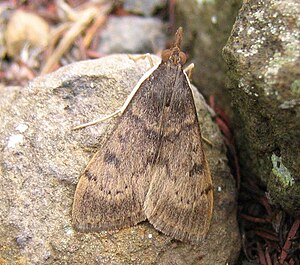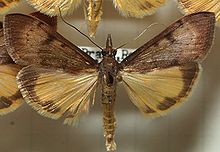Uresiphita gilvata
| Uresiphita gilvata | ||||||||||||
|---|---|---|---|---|---|---|---|---|---|---|---|---|

Uresiphita gilvata |
||||||||||||
| Systematics | ||||||||||||
|
||||||||||||
| Scientific name | ||||||||||||
| Uresiphita gilvata | ||||||||||||
| ( Fabricius , 1794) |
Uresiphita gilvata ( Syn. : Uresiphita limbalis , Mecyna polygonalis ) is a butterfly from the family of Crambidae .
features
The moths reach a wingspan of 29 to 37 millimeters (or a forewing length of 14 to 16 millimeters.) The species is very variable in color and drawing. The basic color ranges from dark yellowish brown to dark brown with gray crossbars. Usually the inner and outer transverse lines are clearly drawn; however, there are also specimens with an almost extinct drawing. The transverse lines are usually darker than the basic color, often more or less broadly light-edged. The inner cross line is wavy, the outer cross line jagged and jumps back strongly at the inner edge. Darker ring and kidney defects are almost always present. The edge of the outer one can sometimes become very wide and reach as far as the flawed kidney, thus forming a wide, gray transverse band. In other specimens, the middle field between the inner and outer transverse line is darkened. Often the outer half of the fringe area is darker than the basic color. The hind wings are yellowish to yellowish brown with a broad dark brown border.
The caterpillar is light yellowish to ash gray in color. The head is glossy black, the warts are covered with individual white bristles.
The pupa is reddish brown and is 11.0 to 13.1 millimeters long and 3.4 to 3.8 millimeters in diameter. It has a fine to medium-fine surface sculpture and medium-long bristles. The cremaster is covered with long bristles that diverge obliquely outwards and downwards.
Geographical distribution and habitat
Uresiphita gilvata occurs in Central and Southern Europe, North Africa, Western Asia and the Canary Islands .
The species prefers dry, warm, open, often rocky habitats . In Central Europe it occurs only very locally and is usually not common. In the Mediterranean area , however, under favorable conditions (e.g. frequent occurrence of Genista species) it can even occur in large numbers.
Way of life
Uresiphita gilvata forms two generations a year. The moths fly from May to September. The oligophagous caterpillars feed on flowers and leaves of broom ( Genista ), gorse ( Ulex ) cytisus ( Cytisus ) and Phaseolus . The caterpillars live in a web of leaves and flowers of the food plants. They pupate in a whitish cocoon; the pupa hibernates.
Systematics
The nomenclature of this taxon is extremely complex; therefore there are three frequently used names for this species in the literature. The taxon was first correctly recognized and named as a separate taxon by Johann Christian Fabricius in 1794 as Phalaena gilvata . However, the species was described a few years earlier (1775) by Michael Denis and Johann Ignaz Schiffermüller as Pyralis limbalis , a name that has found its way into the following literature. Pyralis limbalis is an available name under the International Rules for Zoological Nomenclature , but it cannot be used for this species. It is namely a wrong determination and a simultaneous unjustified emendation (= intended change of name) of the species Phalaena (Geometra) limbata established by Linnaeus (1767) . This taxon is a valid taxon of the genus Evergestis Huebner, 1825 ( Evergestis limbata (Linnaeus, 1767)) and Pyralis limbalis Denis & Schiffermüller, 1775 is formally a younger synonym of this species. The history of the name became even more complicated due to further misuse. In 1825, Hübner actually mapped the taxon described here under Pyralis limbalis Denis & Schiffermüller. In this sense it was determined to be the type species of the genus Uresiphita Huebner, 1825.
The taxon often appears in older literature under the name Mecyna polygonalis (Huebner, 1796). The history of this name is just as complicated. Hübner (1796) mapped the taxon described here under the name Pyralis polygonalis . It is often seen as a new description of the species, but it is only the first attempt to depict the species Pyralis polygonalis Denis & Schiffermüller, 1775. The identity of this taxon is uncertain, however, it is probably a synonym of a species of the genus Udea , perhaps it is an older synonym of Udea fulvalis (Huebner, 1809). Due to the uncertainty in identification, Udea fulvalis (Huebner, 1809) should be preserved. But what Huebner depicts under Pyralis polygonalis Denis & Schiffermüller, 1775, is definitely Uresiphita gilvata (Fabricius, 1794). Pyralis polygonalis Hübner, 1796 as it was often used in literature, is not an available name in the sense of zoological nomenclature. ( noun nullum )
The name Pyralis limbalis sensu Hübner, 1825 (nec Denis & Schiffermüller, 1775), which was erroneously used for this species , was assigned to the type species of the genus Uresiphita Hübner, 1825. As a result, Phalaena gilvata Fabricius is not formal, but de facto the typical species of the genus Uresiphita . Achille Guenée also proposed the new genus Mecyna in 1845 . He did not determine a type species, but added seven species to his new genus; in the first place " Mecyna polygonalis Huebner". Walker (1859) later designated Meyna polygonalis Huebner as the type species. According to the International Rules for Zoological Nomenclature, an incorrectly determined type species is a case that would have to be decided by the Commission. Since Mecyna Guenée is in any case a more recent synonym, either by Udea Guenée, 1845 or by Uresiphita Hübner, 1825, no decision is necessary here. On the other hand, the fundamentally wrong use of the type species by Uresiphita Huebner would actually have to be fixed by the commission in 1825.
Due to the great variability of the species in color and drawing, there are other scientific names (and synonyms ) for this taxon: Pyralis diversalis Huebner, 1796 and Pyralis rusticalis Huebner, 1796, which, however, have not found dissemination in the literature.
Harmful effect
In the Mediterranean, e.g. B. in Liguria , where one of the host plants, Genista monosperma , is grown commercially for cut greenery , Uresiphita gilvata tends to multiply on a large scale and can cause severe damage to the plantations. Pesticides are usually used for control. In a project investigating more natural control of the pest, the brackish wasp Meteorus pulchricornis was used to combat it. It has been shown that this species also parasitizes the caterpillars of Uresiphita gilvata .
swell
- ↑ UK moths - website of Ian Kimber
- ↑ a b Hannemann (1964: p. 332,334) (as Uresiphita äimbalis )
- ↑ Eckstein (1933: p. 66) (as Mecyna polygonalis )
- ↑ Jan Patočka: The pupae of the Central European borer (Lepidoptera: Pyraloidea, Pyralidae). Subfamilies Acentropinae, Odontiinae, Evergestinae and Pyraustinae. In: Linz biological contributions. 33rd volume, issue 1, Linz 2001, pp. 347-405 ( PDF on ZOBODAT ).
- ↑ Slamka (1997: p. 22) (as Uresiphita limbalis )
- ^ A b G. Boddi, R. Petacchi and A. Loni: Prima segnalazione di Meteorus pulchricornis sulla piralide della ginestra [Genista monosperma (L.) Lam.]. Informatore Fitopatologico, 52 (5): 69-72, 2002 ISSN 0020-0735
- ^ Johann Christian Fabricius: Entomologia systematica emendata et aucta: Secundun classes, ordines, genera, species, adjectis synonimis, locis, observationibus, descriptionibus. Volume 3, Part 2 (description p. 208)
- ↑ a b Michael Denis and Johann Ignaz Schiffermüller: Systematic directory of butterflies in the Vienna region. 322 S., Bernardi, Vienna 1776 Online at GDZ - Göttinger Digitization Center (The work Announcement of a systematic work on the butterflies of the Vienna region by Michael Denis and Johann Ignaz Schiffermüller from 1775 is an identical preprint of the digitized work from 1776) (Description by Pyralis limbalis on p. 122 or comment on limbata Linné on p. 121).
- ↑ Natural History Museum - Butterflies and Moths of the World Generic Names and their Type-species
- ^ Carl von Linné: Systema naturæ per regna tria naturæ, secundum classes, ordines, genera, species, cum characteribus, differentiis, synonymis, locis. 12th edition, Stockholm 1767 Online at SUB Göttingen (description by Phalaena Geometra limbata p. 873)
- ↑ a b Homepage: GlobIZ - Global Information System Zünsler (see there under Uresiphita polygonalis )
- ^ Francis Walker: List of the specimens of Lepidopterous insects in the collection of the British Museum. London, 1854–1866 (Part 19: Pyralides, pp. 804, 1859)
literature
- Karl Eckstein: The small butterflies of Germany. Stuttgart 1933.
- Hans-Joachim Hannemann: Small butterflies or Microlepidoptera II. The moths (sl) (Cochylidae and Carposinidae) The moths (Pyraloidea). In: Friedrich Dahl: The animal world of Germany and the adjacent parts of the sea according to their characteristics and their way of life. Part 50., VEB Gustav Fischer Verlag, Jena 1964.
- Ivar Hasenfuss: The Larval systematics of the bulls (Pyralidae). Akademie-Verlag, Berlin 1960, 263 pages.
- František Slamka: The common moth (Pyraloidea) of Central Europe: determination - distribution - flight area - way of life of the caterpillars . 2nd partially revised edition, Bratislava 1997, ISBN 80-967540-2-5 .
Web links
- Lepiforum e. V. (taxonomy and photos)
- Moths and Butterflies of Europe and North Africa
- www.euroleps.ch - Heiner Ziegler's website
- Uresiphita gilvata at Fauna Europaea. Retrieved August 6, 2011
